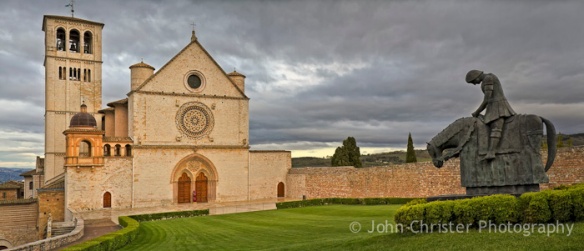 The Basilica di San Francesco is a distinctive landmark that can be seen from miles away as you approach Assisi. As you draw nearer you can appreciate the huge supporting arcades. The Basilica of St. Francis is considered one of the artistic highlights of medieval Europe, as well as one of the most important places of Christian pilgrimage in the world. It is definitely a ‘must see’ while visiting or on pilgrimage as it continues to be a powerful place both for believers and art-lovers alike. The basilica is the mother church of the Roman Catholic Order of Friars Minor more commonly known as the Franciscan Order.
The Basilica di San Francesco is a distinctive landmark that can be seen from miles away as you approach Assisi. As you draw nearer you can appreciate the huge supporting arcades. The Basilica of St. Francis is considered one of the artistic highlights of medieval Europe, as well as one of the most important places of Christian pilgrimage in the world. It is definitely a ‘must see’ while visiting or on pilgrimage as it continues to be a powerful place both for believers and art-lovers alike. The basilica is the mother church of the Roman Catholic Order of Friars Minor more commonly known as the Franciscan Order.
 Brother Francis died in October of 1226 and less than two years later his disciple and fellow-worker Brother Elias (of Cortona) had plans underway for construction of a church in his honor. The Friars Minor, Pope Gregory IX (who, as a cardinal, enjoyed a close friendship with Francis), and the people of Assisi were all involved in supporting the early construction of what became an incongruously grandiose and beautifully embellished memorial to a profoundly converse man who preached and lived a simple life of poverty, abstinence, and renunciation of worldly goods in search of a greater spirituality.
Brother Francis died in October of 1226 and less than two years later his disciple and fellow-worker Brother Elias (of Cortona) had plans underway for construction of a church in his honor. The Friars Minor, Pope Gregory IX (who, as a cardinal, enjoyed a close friendship with Francis), and the people of Assisi were all involved in supporting the early construction of what became an incongruously grandiose and beautifully embellished memorial to a profoundly converse man who preached and lived a simple life of poverty, abstinence, and renunciation of worldly goods in search of a greater spirituality.
It is believed that Brother Elias, although devout, was more worldly that Francis, and the popularity of the Franciscan order through the ages owes a great deal to Elias’ marketing skills.
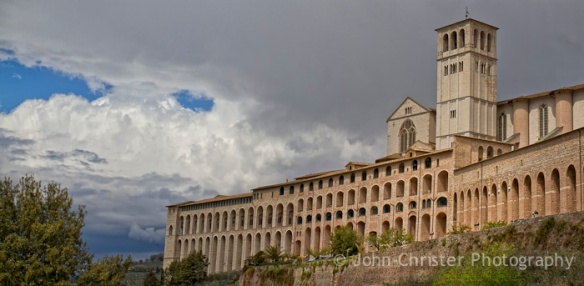 Construction began in 1228. The basilica was built into the side of a hill and actually consists of two churches known as the Upper Church and Lower Church, and the saint’s tomb which is yet below the Lower Church. A site for the church was donated to Pope Gregory by Simone di Pucciarello on the western tip of Asio hill outside the Assisi city walls on what was known as the “Hill of Hell” where criminals were put to death. It is now called the “Hill of Paradise”.
Construction began in 1228. The basilica was built into the side of a hill and actually consists of two churches known as the Upper Church and Lower Church, and the saint’s tomb which is yet below the Lower Church. A site for the church was donated to Pope Gregory by Simone di Pucciarello on the western tip of Asio hill outside the Assisi city walls on what was known as the “Hill of Hell” where criminals were put to death. It is now called the “Hill of Paradise”.
Francis was declared a saint on July 16, 1228 and the following day the pope laid the first stone of the Church of St. Francis. The Lower Church was quickly finished by 1230, and on Pentecost May 25, 1230 the body of St. Francis was taken from its temporary burial place St. George, now the Basilica of Saint Clare of Assisi, to the Lower Church (or Lower Basilica). The actual burial place was hidden in the earth beneath the high alter and sealed up with stone to protect St. Francis’ remains. It was not till 1818 that the tomb of St. Francis was rediscovered beneath the high altar. After being hidden for nearly 600 years the coffin was opened and Francis’ skeleton was found completely intact. A new crypt was built first in neo-Classical style then later in a simpler neo-Romanesque style. Thus modern pilgrims are able to approach the very tomb of St. Francis, which no medieval pilgrims were ever able to do. (Notes from Sacred Destinations)
Construction was begun on the Upper Church in 1239 and completed in 1253. Both churches were consecrated by Pope Innocent IV in 1253 and designated a Major Basilica in 1288. On September 26, 1997 two earthquakes hit this region of Italy damaging many ancient buildings. The Lower Church walls are nearly nine feet thick and were unscathed while the Upper Church with larger windows and walls only three feet thick were damaged. An aftershock killed two Franciscan friars and two specialists while they were inspecting the damage to the Basilica. Many of the frescoes of the life of St. Francis by Giotto in the Upper Church were destroyed in the collapse. The basilica was closed for two years for restoration.
The photo above shows the lower piazza and the side entrance to the Lower Church in the early morning before the activity of the day. The alternating striped colors of the street almost seem like an escalator drawing you toward the grand side entrance.
 Below, a pilgrim is enjoying a time of reflection in the quiet of the early morning under the arched colonnade lining the sides of the Piazza Inferiore. The colonnades were added in the 15th century.
Below, a pilgrim is enjoying a time of reflection in the quiet of the early morning under the arched colonnade lining the sides of the Piazza Inferiore. The colonnades were added in the 15th century.
 An example of more recent artwork under the colonnade of the lower piazza.
An example of more recent artwork under the colonnade of the lower piazza.
By mid day the piazza becomes a hub of activity with tourists and pilgrims. Here are a couple of young art students on an “art venture”.
 This is the grand side entrance to the Lower Church showing the stairway to the Upper Piazza and Upper Church and the benediction loggia on the left side of the facade and supporting curtain wall which was added in 1754.
This is the grand side entrance to the Lower Church showing the stairway to the Upper Piazza and Upper Church and the benediction loggia on the left side of the facade and supporting curtain wall which was added in 1754.
 Above the doors is an ornate pediment containing a large rose window, flanked by two smaller ones, called by some “the eye of the most beautiful church in the world.”
Above the doors is an ornate pediment containing a large rose window, flanked by two smaller ones, called by some “the eye of the most beautiful church in the world.”
 Wooden decorations on the doors by Ugolinuccio da Gubbio done circa 1550.
Wooden decorations on the doors by Ugolinuccio da Gubbio done circa 1550.


 Since the Basilica is located on the far western end of the hill it offers wonderful views overlooking the valley below.
Since the Basilica is located on the far western end of the hill it offers wonderful views overlooking the valley below.
 This is the view from the portico of the Upper Church showing the Franciscan Tau, PAX, and the equestrian statue of St. Francis.
This is the view from the portico of the Upper Church showing the Franciscan Tau, PAX, and the equestrian statue of St. Francis.
 The Upper Church has white-washed brick facade and a Gothic doorway with a Romanesque rose window.
The Upper Church has white-washed brick facade and a Gothic doorway with a Romanesque rose window.


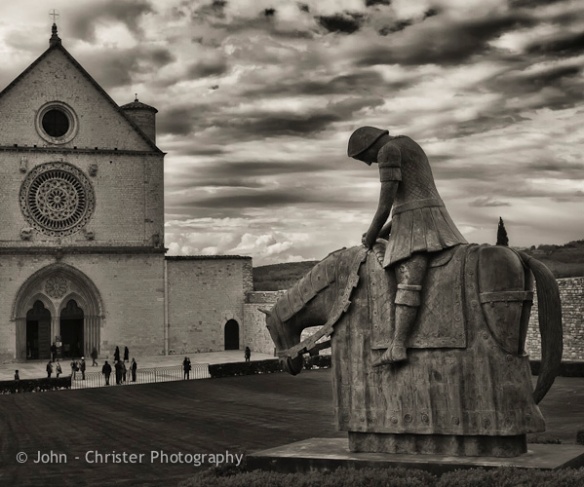 This equestrian statue is one of my favorites showing Francis with his head hung low as he slinks back home after God has told him to “let go” of his dream of becoming a heroic “knight in shining armor” and to instead follow the way of Jesus.
This equestrian statue is one of my favorites showing Francis with his head hung low as he slinks back home after God has told him to “let go” of his dream of becoming a heroic “knight in shining armor” and to instead follow the way of Jesus. As much as the outside architecture of the basilica is interesting and beautiful, the inside of the basilica is even more so. It is frescoed from top to bottom by the leading artists of the day with works from Cimabue, Giotto, Simone Martini, and Pietro Lorenzetti. Unfortunately photography was not permitted inside. But taking time to experience the inside will convince you that it is as spectacular as the Vatican or St. Peter’s Cathedral in a simpler beauty.
As much as the outside architecture of the basilica is interesting and beautiful, the inside of the basilica is even more so. It is frescoed from top to bottom by the leading artists of the day with works from Cimabue, Giotto, Simone Martini, and Pietro Lorenzetti. Unfortunately photography was not permitted inside. But taking time to experience the inside will convince you that it is as spectacular as the Vatican or St. Peter’s Cathedral in a simpler beauty.  Discovery Venture Tours has scheduled another Spirit Venture – “Chasing Francis” next year from March 19th to the 29th. We will be spending 6 nights in Assisi and 4 nights in Rome. Below is the brochure. It was such an amazing experience many of us are going back. Let us know if you are interested in joining us.
Discovery Venture Tours has scheduled another Spirit Venture – “Chasing Francis” next year from March 19th to the 29th. We will be spending 6 nights in Assisi and 4 nights in Rome. Below is the brochure. It was such an amazing experience many of us are going back. Let us know if you are interested in joining us.
(Notes from Rick Steves, Sacred Destinations, and Wikipedia)




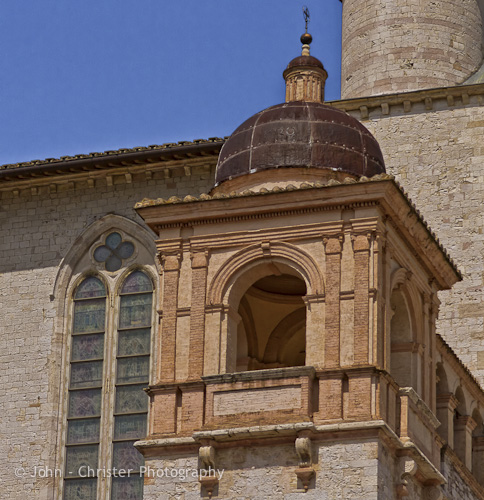
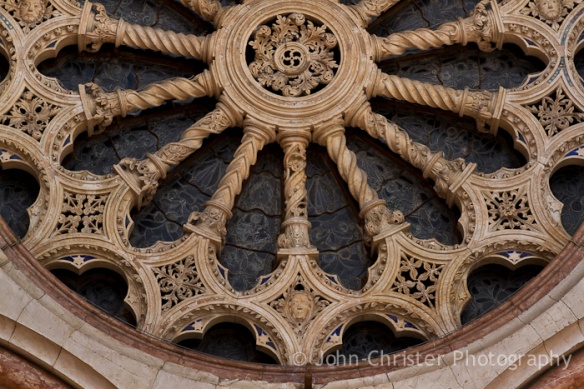
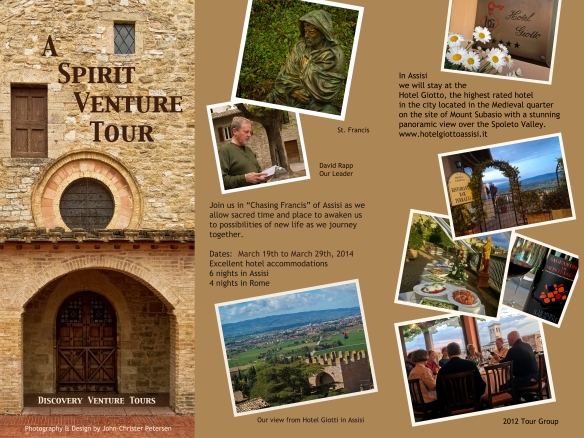

You must be logged in to post a comment.